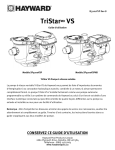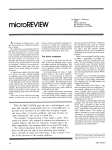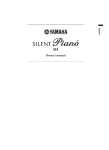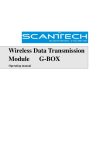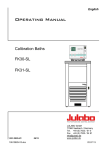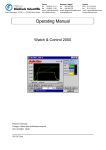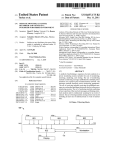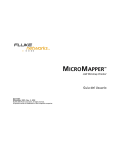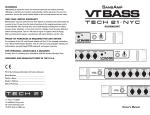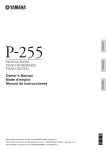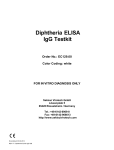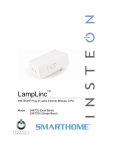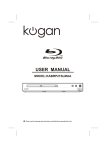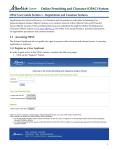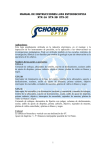Download New Products
Transcript
NEWI PRODUCTS New Products Editor: Demetrios A. Michalopoulos California State University, Fullerton Interactive processing system is IBM MVS compatible Dialogic Systems Corporation has introduced a computer system designed to achieve interactive processing in the large IBM or plug-compatible mainframe environment. The Dialogic/One system implements layered interactive processing by integrating the Dialogic/10 satellite computer into the IBM MVS system environment. With the Dialogic/ One system, the mainframe continues to perform batch processing and database management while the satellite computer performs the interactive processing. Each machine can be optimized for the tasks it performs best, while the interactive user at his 3270-type terminal continues to view the two machines as a single, familiar system. The Dialogic/10 satellite computer hardware architecture is based on multiple microprocessors working in parallel and is interconnected through a wide-band communications channel, sharing access to a high-performance, hard-disk-drive system. The system's software consists of a replacement for IBM's TSO and an operating system distributed between the mainframe and the satellite computer. The user software, a superset of TSO, includes a set of application packages specifically targeted for application developers and system programmers and a high-level command language for developing customerwritten applications. The application packages include an editor interface similar to IBM's interactive system productivity facility editor. They also enable data processing users to perform extended Cobol editing and the full management of Telephone/computer terminal is desktop communications center Digital Transactions, Inc., has announced its entry into the emerging "super-smart " telephone market with an integrated telephone/ computer terminal. The Telterminal has been designed for the white-collar worker who has long considered the computer too complex and expensive for personal use. A major feature of Telterminal is the management assistance package that gives the user single-key access to an array of communication and information capabilities. Users can input a speed-call directory for as many as 250 local and network access numbers and sign-on and security identifiers. This directory facilitates sending and receiving attended and unattended voice and data messages. In addition to PBX telephone features such as call forwarding, call holding, last number re-try, and on-hook dialing with line monitor, the Telterminal's personal processing capabilities include programmable financial and/or scientific calculator, a calendar, and a pink-slip message center. Call message detail recording for project or client accounting is a standard part of Telterminal and can be output to a local printer or display and/or uploaded to another computer system for processing. The Telterminal can also use IBM PC-compatible software programs. The "personality module" features customization for a wide variety of special applications defined by the user, such as specific menu drivers, protocol and format needs, and transmission speed requirements when accessing proprietary databases. The expansion capabilities of the Telterminal can also provide for electronic mail messaging and electronic funds transfer activities. Digital Transactions' Telterminal sells for $2495. Reader Service Number 30 host MVS system facilities. According to the company, productivity is increased through better response time and also through the enhanced functions supplied in the application packages. The Dialogic/ One system is priced from $198,000 to $385,000 depending software is available paid-up license. on the configuration; on a monthly or fully Reader Service Number 29 126 Measuring 16x9x2V2 inches, Digital Transactions' Telterminal looks like a business telephone. Positioned between the receiver and the touch-tone dialing system is the familiar typing keyboard and a row of function or command keys. Above the keyboard, an LCD window provides text messages and other information. COMPUTER Logic analyzers have a dual-time base Dolch Logic Instruments has announced the 64300 series logic analysis systems. Fully modular in 16-channel increments, the 64300. provides 64 channels in a full-up configuration, which includes 16 300-MHz (3.3-ns resolution) asynchronous channels for timing analysis and 48 25/50-MHz synchronous/ asynchronous channels for timing/state analysis. The company states that in time measurements, the 64300 is the only logic analyzer available with a genuine dual-time base; it can capture and correlate independently clocked signals, and overlay a 300-MHz acquisition capability on any channel. A 300-MHz capability is designed to give the user a truer picture of the operation of the system under test by permitting a 3.3-ns resolution with glitch detection capabilities. The analyzer offers microprocessor-specific interfaces and disassemblers for all popular eight- and 16-bit processors, and these incorporate features such as 12-level, two-dimensional triggering that help to isolate problems and unravel machine code. Performance features included as standard with the 64300 are multilevel triggering; Datapak integrated, transportable mass memory; multiple internal/external clocking capabilities; search and compare; up-trace module with full disassembly; RS-232-C/IEEE 488 interfacing; and software performance analysis features, including time stamp, area trace, and histogram. An automated vision system to sort a variety of complex parts moving down an assembly line has been announced by View Engineering. The View 1101 multivision system uses a microcomputer that stores in memory complex details of parts, enabling the system to search a part through 360 degrees in 300 milliseconds, the time required to compare a live video image against any stored reference. The price ranges from $20,000 to $70,000, depending on quantity and con- Prices of the 64300 vary from $7930 for a figuration. Reader Service Number 33 16-channel implementation to $14,930 for the 64-channel implementation for 16-bit microData switch connects RS-232-C, current loop, and TTL devices processor and microprocessor-based-system analyses. A line-controlled central exchange for up to Offered as a single-board microcomputer Reader Service Number 31 eight RS-232-C, current loop, and TTL de- or a complete package with an 8K firmware vices is available in a single board or a com- network handler, power supply, and enpletely packaged enclosure from Digital Lab- closure, the data switch incorporates I K RAM oratories. The Micro Matrix II features nonvolatile storage for 16 different switching Acoustical housing reduces patented circuitry that allows the transfer of arrangements. All 64 connection changes ocprinter noise data anywhere in a network of eight RS-232- cur within 7 As with no switching glitches or C, current loop, and TTL devices under soft- transmission interruptions, the company A 26-inch-wide acoustical printer housing, ware control. Providing 64 memory-mapped states. the Soundtrap Stretch from Trace Systems, connection points, the data switch's setup is The Micro Matrix II is priced at $795 for the reduces noise to an average 44-dBA level for simplified by firmware that handles ports by single-board configuration (OEM discounts popular 136-column dot matrix and small user name and includes prompts, a command offered) and $995 for the complete enclosure. daisywheel printers. Noise absorption im- menu, and connection displays. Reader Service Number 34 provements include more surface area and resin-formed top and sides lined with dense foam. Design of the housing includes a "peel-out" Text editor eases mainframe use by PCs slot for bottom-feed printers, louvers in the back panel for ventilation, an angle-shaped Uni/edit from Schonfeld & Associates, is a Uni/edit to conform to any PC or WP. Actext editor designed for mainframes and cording to the company, Uni/edit can also be cover, and a tilted lid with "stay-open" memory hinges. minicomputers that use PCs and WPs as used by all dumb and smart terminals on the The Soundtrap Stretch fits office printers dumb terminals. Uni/edit runs with all same system, preserving prior terminal investsuch as Apple Letter Quality, Brother HR-15, operating systems supporting Fortran 77. It ments as well as providing flexibility. The text C. Itoh Starwriter, Epson MX 100, Man- runs on VAX, DG, IBM, Burroughs, Prime, editor features a natural syntax, a pocketnesmann Tally MT 160/180, NEC, Okidata and CDC systems. Where different systems sized user's manual, on-line Help tutorial, 83A, Qume Sprint 11, Smith Corona, Tran- are used, Uni/edit can serve as a standard and features such as left and right tab column alignment. star 315 color pinter, and Toshiba TH-2100 editor. A one-year license costs $800 for the first PCs and WPs with standard serial commuH/G. The inside dimensions of the model are 26 x 17 inches with height limitations depend- nications can perform text editing on remote CPU and $400 for each additional CPU at the ing on each printer's shape and accessories. host systems. Uni/edit, however, replaces same site. Perpetual and three-year licenses The retail price for the Soundtrap Stretch is mainframe-based screen editors, special emu- are also available. A 40-percent discount is oflator boards and programs for PCs and WPs, fered for educational institutions. $189. expensive editing terminals, and special comReader Service Number 35 Reader Service Number 32 munications gear. Users can command October 1983 127 Real-time spectrum analyzer plugs into IBM PCs Assembly language subroutines handle all The Ariel Corporation's RTA 331 is a l/3-octave real-time audio frequency spectrum high-speed operations. All subroutines are ac'analyzer that plugs into a single expansion slot cessed from Basic, so users can create new and inside the IBM PC. The analyzer divides the specialized applications such as digital signal audio spectrum into 31 "/3-octave bands from processing and speech synthesis or recogni20 kHz to 20 kHz and interactively displays tion. The RTA 331 features on-board pink the relative amplitude of each frequency noise generator, digitally controlled gain, 1/4 band. The unit can also convert an incoming dB resolution, and ANSI A, B, or useraudio signal to eight-bit samples and store it in defined weighting, averaging, and peak-hold the PC's 512K-byte main memory in which 20 functions. Ariel's RTA 331 analyzer is priced at $650. seconds of audio can be stored. Any block of memory can be similarly read out using the analyzer's eight-bit DAC. Reader Service Number 36 Video image processor stores image data digitally A video image processor designed to convert radar or sonar video signals to TV raster scan for display on a standard television monitor has been introduced by Hughes Aircraft Company's industrial products division. According to the company, operators no longer have to rely on long-persistence phosphors in their CRT monitors for retention of target images until refreshed by the next sweep of the antenna. With the Model 666, image data is stored digitally and can be displayed continuously. The image can be displayed on remote or local monitors, or it can be recorded on videotape. The radar/sonar image can be viewed in normal ambient lighting, eliminating the need for a darkened room. The processed image is electronically smoothed to provide an appearance similar to that of a conventional television display. When activated, selectable image fade algorithms emulate the phosphor fade characteristic of an analog radar display. Stored information can be displayed simultaneously with dynamically updated information. A vertical gray calibration scale appears at the side of the radar/sonar display, and alphanumeric legends and messages can be overlayed on the image or written in designated locations outside the displayed image area. Memory consists of MOS dynamic RAMs organized 512 x 512 x 4 bits, and image resolution is 512 pixels per line x 480 lines. The unit is microprocessor controlled with up to 8K bytes of program memory and 768 bytes of RAM to execute processing commands. Analog sweeps can be entered with sweep speeds up to 51 microseconds full scale and a pulse repetition frequency up to 1000 Hz. The single-unit domestic base price is $25,000. Reader Service Number 37 Filing/writing for IBM PCs program offered Fast Facts, a filing system/report writing for executives, office workers, and home users of IBM PCs and compatibles from Innovative Software, runs on both monochrome and color machines. According to the company, any information normally stored on file cards or in a filing cabinet-from personnel records to mailing lists to recipes-can be stored with Fast Facts. Information can be called up by last name, by address, by zip code, and in combinations; AND/OR statements are allowed. Fast Facts can write information to other spreadsheet programs, such as VisiCalc, 1 2 3, and MultiPlan, in a DIF data storage format, and interface to Wordstar through an ASCII interface, which allows the user to generate form letters. Fast Facts has a built-in calculator which, when called up, prints across the bottom of the screen. Every screen has Help menus that use plain English and tutorial information to walk users through a process. Forms can be developed by the program to include both text and graphics. Fast Facts has Enter, Search, and Display functions and can copy files and add pages. Utility options permit the user to change default parameters, display files, rename a file, organize a logged-on file, redesign a form, or use the DIF interface. The program allows 1000 forms per file, up to 50 pages per form, and 100 items per page; a page is one screen, 80 columns wide and 20 rows long. Two disk drives, either two floppies or one floppy and one hard disk with 128K RAM, are required; a printer is optional. Suggested retail price is $195. program Reader Service Number 35 Statistical multiplexers offered in four versions Options on the Model 666 video image processor from Hughes Aircraft Company's industrial products division include rectangular display formats, electronic calipers with automatic digital display of distance between calipers, auxiliary data readout, and 2X and 4X read zoom. 128 The Multi-Mux series of statistical multiplexers from Multi-Tech Systems is available in one-, two-, four-, and eight-channel versions. Both point-to-point and multipoint networks can be supported by the units. The Multi-Mux channel accepts asynchronous data at any speed up to 9600 bps for transmission over a single, synchronous, fullduplex link. Total peak input rate is 19,200 bps. Channel speeds and flow-control methods can be individually configured from either local or remote sites. Automatic speed selection, dynamic buffer allocation, and CRC error detection/correction are also provided. Diagnostic capabilities with local, remote, and self-test; individual link and channel XMT/RCV indicators; and seven system status indicators are provided. When used in multipoint networks, the Multi-Mux provides poll-addressing capability for nonintelligent terminal sites. A typical four-channel version lists for $1295, and an eight-channel unit for $2095. Reader Service Number 39 COMPUTER Portable logic analyzer incorporates CP/M micro The portable, 27-pound Omni 11 logic analyzer from Omnilogic, Inc., integrates a timing/state logic analyzer with a full-function CP/M microcomputer while incorporating a software-intensive design approach. Used as an interface between the engineer and complex digital problems, the Omni II can collect 1000 data samples on each of 16 channels or, optionally, up to 48 channels of 330 samples each. Four channels of glitch detection are provided with a minimum detectable pulse of 10 ns. The system utilizes internal or external clocks as fast as 20 MHz, either of which can be qualified. Triggering modes include the basic AND/OR/NOT on data or glitch, with the trigger point positioned within the 1000-word sample memory. Additional triggering modes are absence of repetitive event, repeat until correlated with reference memory, and delay by event or time. External trigger and trigger qualifier are also provided. Two rear-panel connectors supply clock and trigger outputs. Upon power-up, the Ommni II invokes an automatic self-check of its internal circuitry, and a "setup page" automatically appears to permit configuration of the machine for data collection. After data collection, the analyzer provides the timing analysis for hardware troubleshooting and software analysis. The integral CP/M computer utilizes a Z80 CPU and 64K of RAM. Mass storage is provided by two 5¼/4-inch, double-density disk drives. The built-in, nine-inch monitor displays 24 rows by 80 columns in P31 green phosphor. A detachable ASCII keyboard, with its cursor control keys and numeric pad, provides control of Converter system makes MSDOS and CP/M-86 compatible Omnilogic's Omni 11 logic analyzer is a portable unit that provides up to 16 channels of data recognition. An optional plug-in module permits up to 48 channels and bus demultiplexing. the logic analyzer and computer. Omni 11 also offers seven CP/M programs, such as a word processor, a high-level language, and an electronic spreadsheet. Another feature of the Omni II is its signature analysis capability. It can derive the hexadecimal signature of 14 independent test points simultaneously. These results can then be compared automatically with a set of Reader Service Number 40 October 1983 All digital testing parameters, data, and time and date can be stored on disk, with CP/M compatibility, for additional off-line analysis. With the connection of a printer, the Omni II can provide hard copy of displays. The Omni 11 is priced at $3950. Reader Service Number 41 Corporate stock option system is IBM PC-compatible Stork 1.0, a system for managing corporate plans, runs on the IBM PC, PCUsers of 16-bit microcomputers can run stock optionmachines, and most CP/M microsoftware written for two popular operating compatible available from The Baily and is computers on a systems single microcomputer with the Company. Stork 1.0 keeps track of incentive OS Converter from Dynamic Microprocessor Associates. The OS Converter permits PCDOS (MS-DOS) object code to run on CP/M-86 microcomputers and enables CP/M-86 object code to run on MS-DOS with no loss of speed, according to the company. Users can run such programs as MicroSoft Basic and Fortran, Digital Research Pascal, and other language compilers, as well as utilities like Microsoft Assembler and Linker. The 4K-byte program operates by loading a target program into memory and creating the environment that the program expects. There is no interpretation of instructions; the program itself remains in control of operations. When in use, the converter resides just above the operating system in RAM and enables the program being run to take full adavantage of available memory. The OS Converter for the IBM PC is supplied with a companion program that enables PC-DOS systems to read CP/M-86 files. The $95 OS Converter is available for use with either PC-DOS (MS-DOS) or CP/M-86. "known good" signatures previously saved on disk. stock options, nonqualified options, and stock appreciation rights. Full-screen data entry onto preprogrammed formats allows the manager to add information as grants and exercises occur. The system can generate 13 standard reports and answer current and his- torical questions on exercised or outstanding options. Programs are written in dBase II, and data files are standard ASCII text. Files can be downloaded from a mainframe computer directly into the system files. The stock option management system can be licensed for a one-time fee of $6000, plus $500 for a dBase 11 license. Reader Service Number 42 Protocol converter links ASCII devices to IBM world The Avatar PA1000 protocol converter, manufactured by 3R Computers, links ASCII terminals, PCs, portable computers, or other ASCII devices, to IBM BSC or SNA/SDLC environments. The device also permits local or remote access to asynchronous hosts and to public information or timesharing services. The PA1000 provides IBM 3278/2 terminal emulation via its coaxial port. Two standard RS,232-C ports connect both the ASCII device and an asynchronous host, printer, or a modem for remote communications. The microprocessor-based unit, which supports up to 9600 baud, also includes memory for screen buffers and protocol conversion. The Avatar device can be configured in a variety of ways: local terminal, personal, or portable computer connection to IBM with a pass-through mode of operation for screen content printing; local ASCII device connection to both IBM and asynchronous hosts in a distributed processing environment; remote ASCII device access via modems to an IBM environment; and local access to an IBM host and to one or more remote asynchronous systems. Available for immediate delivery, the PA1000 is priced at $995 with quantity discounts available. Reader Service Number 43 129 Interface connects computers or A series of telecommunication devices that permit computers, word procesors, or printers to be interconnected with domestic and international telex systems without bulky and expensive telex hardware has been introduced by Teleface Corporation. The Telexplug is designed to adapt computer-related equipment as the transmission media for entering telex, TWX, or DDD networks, thus bypassing conventional telex machines. Only one party in an exchange between companies or individuals needs the new interface in place to access the various telex systems and conduct "conversation." The interface operates on a microcomputer chip that permits the design of a low-cost gateway to various communications systems. The chip gives the interface the capability to handle code and speed conversions up to 9600 baud. Telexplug can be interposed directly between a computer or word processor and its printer or other output peripheral, permitting connection through use of supplied cable to equipment with a single port. It can also be connected to a separate communications port, allowing the equipment interfaced to engage in unrestricted communication with the new device. In this arrangement, Telexplug acts as WPs to telex lines a modem to open two-way access between computer elements and the telex network. A flexible memory enables the interface to store incoming messages if connected computers or printers are busy; once the connecting equipment is free, the telex message distribution is activated. Users can choose from block or conversational telex modes for outgoing messages. Once outgoing messages have been prepared and edited on a user's computer, the Telexplug is activated, either directly or through a printer and sends the message by itself-dialing, establishing connection, giving and accepting answer-backs (an identification signal of up to 20 characters), and transmitting the message. Other features of the device include multilinking to a telex line, direct and exclusive access for confidentiality, unattended operation, message repetition self-diagnosis and the ability to send different types of printed matter-via ASCII serial asynchronous format up to 8000 characters, and to store about three incoming and outgoing messages. The cost for each unit of the seven Telexplug models is $1270. Reader Service Number 44 Universal counter takes measurements automatically Hewlett-Packard's HP 5334A universal counter allows users to measure frequency, period, rise time, fall time, pulse width, and peak-to-peak volts automatically at the touch of a button. Auto trigger, auto attenuation, and internal storage of up to 10 complete front-panel setups are designed to simplify measurements and operation. Math capability lets users view results in familiar engineering units, if desired. Key instrument features include two-channel, 100-MHz capability; nine-digits-persecond resolution; two-nanosecond singleshot time interval (200 picoseconds with averaging); and keyboard-selectable gate times in millisecond increments from one millisecond to 99.99 seconds. In addition to performing the standard counter measurements of frequency and time interval, the HP 5334A includes period, ratio, and totalize measurements. It also has external arming capabilities. Rear terminals simplify cabling in rack-mounted systems. Options include a high-stability oven oscillator, a 1000V floating DVM, and a 1.3-GHz C channel. External arming and gating allow many applications, such as measuring the frequency within a pulsed RF signal, averaging bursts for irncreased resolution, selecting a specific time interval within a pulse train, and selecting a portion of a pulse train to be totalized. The price of the HP 5334A is $2800. Reader Service Number 45 New Ltrature IBM PC source book. This where-to-find-it directory of software, hardware and accessories for the IBM PC and IBM-compatible microcomputers is organized by numerous subject catagories. Names and addresses of hundreds of companies are included. The Blue Book for the IBM Personal Computer, WIDL Video Publications, 5245 West Diversey, Chicago, IL 60639; (312) 622-9606; $24.95; 328 pp. Data on transistors. Publication presents technical information for both bipolar and field-effect transistors that constitute the Motorola small-signal transistor line. SmallSignal Transistor Data Book, Motorola Semiconductor Products, Inc., PO Box 20912, Phoenix, AZ 85036; $6.25. Software productivity. Semiannual directory of software products, or tools, that can help to improve the productivity of the systems development function covers over 400 software products in some 20 classifications. Guide to Software Productivity Aids, Applied Computer Research, PO Box 9280, Phoenix, AZ 85068; $95 per year. Robotics. Monthly newsletter will cover developments in hardware and software, market trends, applications, government legislation, and news concerning people and companies in the personal robotics industry. Personal Robotics News, PRN Publishing Company, PO Box 10058, Berkely, CA 94709; (415) 524-7115; subscription, $125. Terminal and PC directory. Report identifies 87 major user-programmable terminal systems and 51 personal computers employed for general-purpose processing in data communications environment. Personal Computers and User-Programmable Terminals, Data Decisions, 20 Brace Road, Cherry Hill, NY 08034; (609) 429-7100; $29; 26 pp. Rotating memory ICs. Brochure illustrated with block diagrams and tables describes company's product line. Rotating Memory Integrated Circuits, Silicon Systems, Inc., 14351 Myford Road, Tustin, CA 92680; (714) 731-7110; free; 8 pp. The HP 5334A universal counter from Hewlett-Packard offers full HP-IB capability for automatic operation with a computer and integration with other instrumentation in laboratory or production applications. 130 X-Net primer. Brochure describes the full range of applications, functions, and components of the X-Net local and wide-area data communications network. Available from CR Computer Systems, Inc., 1145 W. Collins Ave., Orange, CA 92667; (714) 633-8660; 12 pp. COMPUTER





